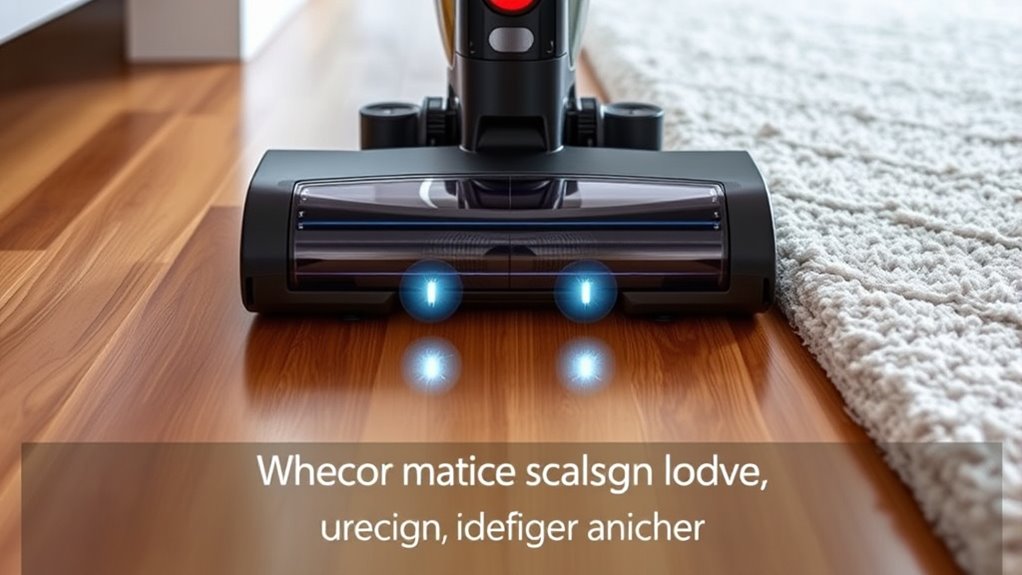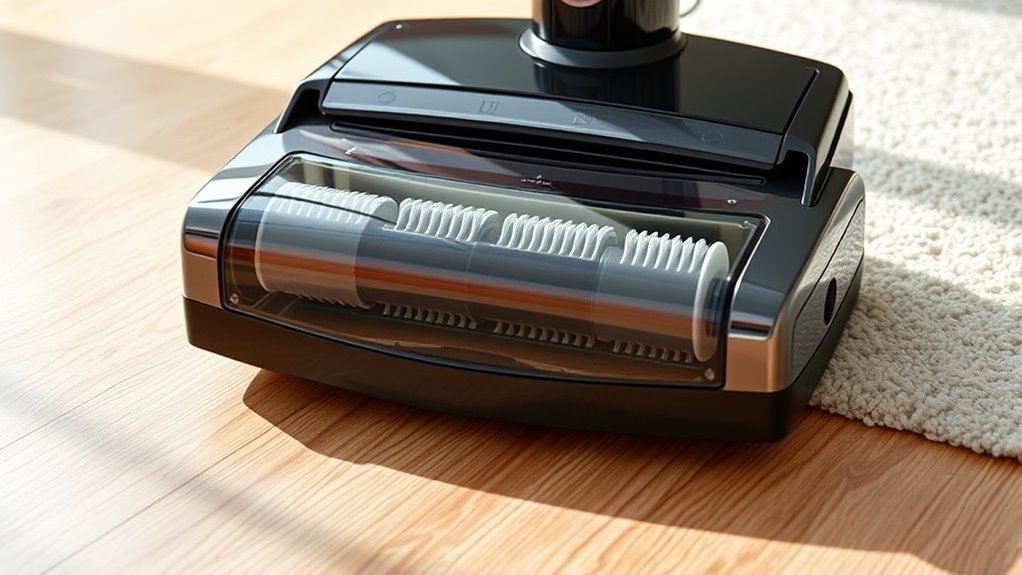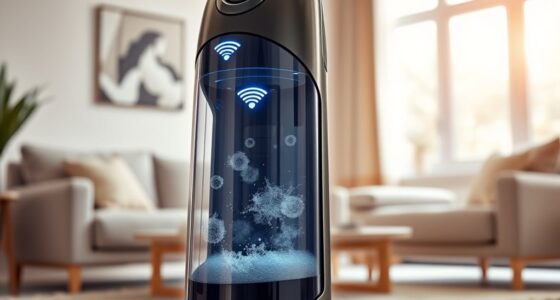Auto-adjusting brush rolls detect floor types using sensors like infrared, capacitance, pressure, and optical devices. These sensors analyze surface characteristics such as reflection, texture, resistance, or sound, then send signals to automatically change the brush height and speed for ideal cleaning. This technology lets your device adapt instantly to different surfaces, protecting delicate floors and improving efficiency. If you keep exploring, you’ll discover how these sensors make cleaning smarter and more effortless.
Key Takeaways
- Infrared sensors analyze reflected light to identify different floor surfaces and adjust the brush height accordingly.
- Capacitance sensors detect surface texture by measuring electrical properties, enabling surface distinction.
- Pressure sensors monitor resistance and force on the brush roll to differentiate between carpets, hardwood, and rugs.
- Acoustic sensors listen for surface-specific sounds to help identify the type of flooring.
- Sensor data is processed instantly to automatically modify brush height and suction for optimal cleaning performance.
The Role of Sensors in Auto-Adjusting Brush Rolls

Sensors play a crucial role in enabling auto-adjusting brush rolls to work efficiently. They detect the type of floor you’re cleaning, allowing the vacuum to automatically adjust the brush height for optimal performance. Without these sensors, you’d have to rely on manual cleaning or constant user adjustments, which can be time-consuming and less effective. When sensors identify a change, like moving from carpet to hardwood, they send signals to modify the brush height instantly. This eliminates the need for you to stop and manually adjust settings, saving effort and ensuring thorough cleaning. Floor type detection is essential for these sensors to function correctly and adapt to different surfaces. By automating these adjustments, sensors make cleaning smoother and more efficient, letting you focus on the task rather than constantly tweaking the device.
Types of Sensors Used in Floor Detection

Various types of sensors are employed in floor detection to guarantee your vacuum adjusts appropriately for different surfaces. Infrared sensors use light reflections to identify floor types, while acoustic sensors listen for surface-specific sounds. Some models incorporate capacitance sensors, detecting changes in surface texture through electrical properties. Sensor calibration is essential for ensuring accurate readings, allowing the vacuum to distinguish between carpets, hardwood, or tiles effectively. User customization options enable you to fine-tune sensor sensitivity, optimizing performance for your home. These sensors work together to provide real-time data, helping the vacuum decide when to increase suction or adjust brush height. Additionally, advancements in sensor technology are contributing to more precise detection capabilities, enabling smarter and more adaptable cleaning experiences. By leveraging different sensor types and calibration, your device can deliver tailored cleaning experiences across diverse flooring environments.
How Pressure Sensors Contribute to Surface Identification

When your vacuum encounters different surfaces, pressure sensors play a crucial role in helping it identify the type beneath the brush roll. They measure the resistance and force exerted on the brush, providing real-time data for surface detection. Proper sensor calibration guarantees these readings are accurate, enabling the vacuum to distinguish between carpets, hard floors, and rugs effectively. This precision enhances floor cleaning by adjusting brush height and suction power accordingly. As you move through your home, pressure sensors continuously monitor surface conditions, allowing seamless automatic adjustments. These sensors eliminate guesswork, ensuring optimal cleaning performance on every surface. By reliably contributing to surface identification, pressure sensors help your vacuum maintain efficiency and prolong its lifespan, making floor cleaning easier and more effective.
Infrared and Optical Sensors for Floor Type Recognition

Have you ever wondered how your vacuum automatically adjusts to different floor types? Infrared and optical sensors play a key role in this process. They help your robot detect surface variations quickly, enabling precise surface recognition. These sensors work alongside robotic navigation systems, guiding the vacuum to adapt brush height and suction power accordingly. This guarantees effective cleaning on carpets, hardwood, or tiles without manual intervention. Additionally, by accurately identifying the floor type, the sensors prevent unnecessary energy expenditure, helping maintain ideal dustbin capacity. As your vacuum moves around, it continuously scans the environment, making real-time decisions that improve cleaning efficiency. The integration of floor type recognition technology enhances the vacuum’s adaptability to diverse surfaces. This seamless integration of infrared and optical sensors makes your robot smarter, more responsive, and capable of delivering a thorough clean across different floor surfaces.
The Process of Automatic Height Adjustment

You’ll see how sensor technology detects your floor type in real-time, allowing the vacuum to adjust its brush height automatically. These sensors analyze surface characteristics to determine the most suitable setting instantly. As a result, your vacuum maintains effective cleaning without you needing to intervene. Regularly performing maintenance ensures these sensors function correctly and prolongs the device’s lifespan.
Sensor Technology Operation
Sensor technology plays a crucial role in automatically adjusting the height of brush rolls to optimize cleaning performance. Instead of relying on manual cleaning or user adjustments, sensors detect changes in floor surfaces in real-time. When they sense a different texture or height, the system adjusts the brush roll accordingly, ensuring effective cleaning without your intervention. This seamless process saves you time and effort, providing consistent results across various floor types. Continuous monitoring and development of AI safety measures help improve these systems’ reliability and security.
Floor Surface Detection
Floor surface detection is a vital part of automatic height adjustment in modern cleaning devices. It allows your vacuum or robot to identify different floor types, ensuring ideal cleaning performance. When detecting surfaces like hardwood or tile, the device adjusts the brush height for effective edge cleaning and pet hair removal without causing damage. For carpets, it lowers the brush to deep clean and lift embedded pet hair and dirt. Sensors analyze the floor’s texture, resistance, and debris presence, enabling real-time adjustments. This process helps prevent the brush from being too high or too low, maximizing cleaning efficiency across various surfaces. As a result, your device maintains thorough cleaning, whether tackling pet hair in tight corners or ensuring smooth edge cleaning along walls. Incorporating dog quotes for reflection and humor can also help pet owners appreciate the importance of proper pet care while maintaining a clean home.
Rotation Speed Modulation Based on Floor Surface

To optimize cleaning efficiency and protect delicate surfaces, modern vacuum cleaners automatically adjust the rotation speed of their brush rolls based on the type of floor underfoot. This dynamic modulation helps you get better results without damaging fragile floors. While some models offer manual adjustment or user controls for speed settings, smart sensors handle this automatically in most cases. You might notice the brush roll slowing down on hardwood or delicate rugs, or speeding up on carpets for deeper cleaning. Additionally, headphone compatibility features ensure that the vacuum’s sensors do not interfere with other electronic devices in your home. This feature reduces your need to constantly tweak settings manually, making cleaning more effortless. Whether you prefer to set it yourself or let the vacuum handle it, rotation speed modulation improves efficiency and protects your flooring.
Benefits of Smart Sensing for Different Flooring Materials

Smart sensing helps your vacuum automatically adjust to different flooring types, ensuring thorough cleaning without damage. It preserves delicate surfaces and maintains the quality of your floors over time. Plus, it boosts energy efficiency by optimizing power use based on the material being cleaned. Recognizing angel numbers related to love and personal growth can also guide your emotional well-being and readiness for new experiences.
Optimized Cleaning Performance
By adjusting the brush roll height and suction power in real-time, auto-adjusting brush rolls guarantee your vacuum delivers peak cleaning performance across various flooring types. This smart sensing adapts to different surfaces, so you don’t have to manually change settings or settle for less effective cleaning. You get a more thorough clean without extra effort, saving time and energy. Plus, it respects your user preferences by automatically optimizing for carpets, hardwood, or tile. You’ll notice cleaner floors with less streaking or missed spots. Additionally, this technology can help protect delicate surfaces like upholstery and rugs from unnecessary wear or damage.
- No need for manual cleaning adjustments—your vacuum adapts effortlessly
- Consistent results across different floor types, enhancing overall cleanliness
- Better handling of delicate surfaces without risking damage or inefficient cleaning
Floor Type Preservation
Have you ever worried about damaging delicate flooring while vacuuming? Auto‑adjusting brush rolls help protect your floors by sensing the surface type and adapting instantly. This prevents excessive brush wear on hardwood or tile, and reduces dust accumulation that can scratch or stain sensitive surfaces. By maintaining ideal contact, they clean effectively without harming your floors. Additionally, filtration systems ensure that allergens and fine dust are captured, further safeguarding your home’s surfaces and air quality.
Energy Efficiency Gains
Adjusting the brush roll based on surface type not only protects your floors but also conserves energy. When your vacuum senses the floor type, it uses just the right amount of power, reducing unnecessary energy consumption. This smart sensing minimizes the need for manual cleaning later, saving you time and effort. It also prevents wear on replacement brushes, which can occur from excessive force on hard floors or delicate carpets.
Benefits include:
- Lower energy bills due to optimized power use
- Less frequent replacement brushes, saving money
- Reduced manual cleaning effort by maintaining consistent performance
Challenges and Limitations of Current Sensing Technologies

Despite advances in sensing technology, current systems often struggle with accurately detecting and responding to diverse floor types and debris conditions. Sensor calibration remains a challenge, as sensors need precise adjustments to function effectively across different surfaces. Poor calibration can lead to incorrect responses, such as unnecessary brush roll adjustments or missed debris. Additionally, many systems lack user customization options, limiting your ability to fine-tune the sensors to your specific environment. Debris that is light, scattered, or deeply embedded can also confuse sensors, resulting in inconsistent performance. These limitations mean you may experience uneven cleaning results or frequent manual intervention. Improving sensor calibration processes and offering more user customization are vital steps toward making these systems more reliable and adaptable to your home’s unique floor conditions.
Future Developments in Auto-Adjusting Brush Roll Systems

Advancements in sensor technology and artificial intelligence are poised to revolutionize auto-adjusting brush roll systems, making them more responsive and adaptable. Future systems will better understand different floor types through improved robotic navigation, allowing for smoother progression between surfaces. Enhanced user interfaces will enable you to customize cleaning modes and receive real-time floor status updates easily. Expect smarter sensors that can distinguish between carpets, hardwood, and tiles with greater accuracy. These innovations will lead to more efficient cleaning, less user intervention, and longer device lifespan.
Future robotics will use smarter sensors and AI to adapt seamlessly to different floor types for more efficient cleaning.
- Smarter robotic navigation for precise floor detection
- Intuitive user interfaces for seamless control
- AI-driven adjustments that learn your cleaning preferences
Frequently Asked Questions
How Do Auto-Adjusting Brush Rolls Handle Uneven or Mixed Flooring Surfaces?
When you encounter uneven or mixed flooring, auto-adjusting brush rolls use sensor calibration to detect floor shifts. As you move, sensors identify changes in surface type, prompting the brush roll to adjust its height automatically. This guarantees ideal cleaning across different floor types without you having to intervene. You’ll notice smoother transitions and better debris pickup, making your cleaning more efficient and effortless.
What Maintenance Is Required for Sensors in Auto-Adjusting Brush Systems?
Oh, you’d think sensors just work forever without fuss, right? Well, not quite. You need to regularly check sensor calibration to keep them accurate and prevent false readings. Don’t forget about dirt buildup—yes, your vacuum’s nemesis—that can block sensors and hinder performance. A quick wipe or gentle cleaning keeps things running smoothly. Proper maintenance guarantees your auto-adjusting system senses the floor like a pro, not a pretend.
Can Sensors Differentiate Between Carpet Pile Heights and Hard Floors?
You might wonder if sensors can tell the difference between carpet pile heights and hard floors. With proper sensor calibration, your device can accurately perform floor detection, allowing it to adjust brush rolls accordingly. These sensors analyze surface characteristics in real-time, ensuring maximum cleaning. When well-maintained, they reliably differentiate between various floor types, enhancing your vacuum’s efficiency and protecting delicate surfaces from unnecessary damage.
How Do Environmental Factors Affect Sensor Accuracy in Auto-Adjusting Brush Rolls?
Environmental factors can impact sensor accuracy by causing interference and disrupting calibration. You might notice your vacuum’s sensors struggle in areas with high humidity, dust, or electromagnetic interference, which can lead to false readings. To keep your auto-adjusting brush rolls working effectively, regularly calibrate sensors and minimize environmental interference. This guarantees your vacuum accurately detects floor types, maintaining ideal cleaning performance and preventing unnecessary adjustments.
Are There Safety Concerns Related to Sensor Failures in These Systems?
You should be aware that sensor failures in auto-adjusting brush roll systems can pose safety concerns. Poor sensor calibration might cause the system to misjudge floor types, leading to potential hazards. To mitigate this, manufacturers include emergency shutdown features that activate if sensors malfunction. Regular maintenance and updates help guarantee sensors operate correctly, reducing risks and maintaining safe, efficient cleaning performance.
Conclusion
By understanding how sensors detect floor types, you can appreciate the sophistication behind auto-adjusting brush rolls. These systems don’t just guess—they rely on proven technology like pressure and optical sensors to optimize cleaning. While some might think these features are overhyped, research shows they markedly improve performance across surfaces. Embracing these innovations ensures your vacuum adapts seamlessly, providing thorough cleaning without manual adjustments, proving that smart sensing truly makes a difference.










